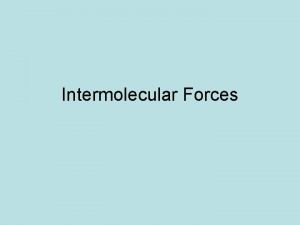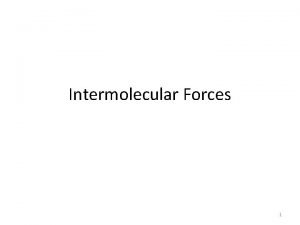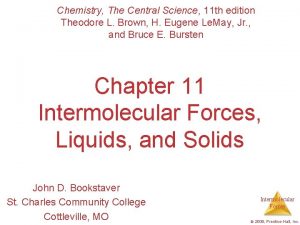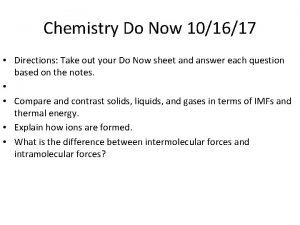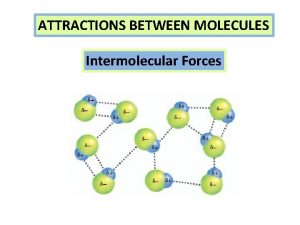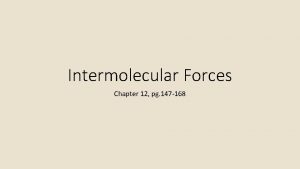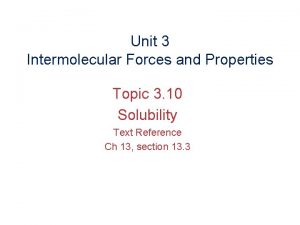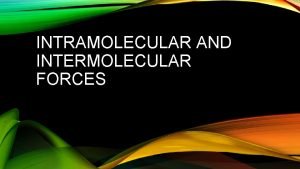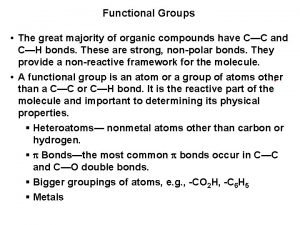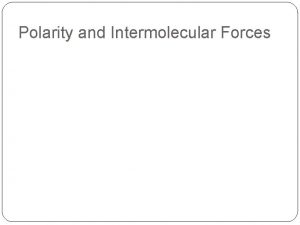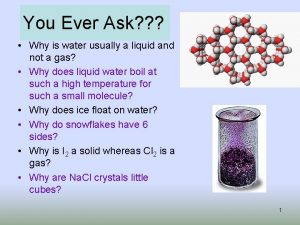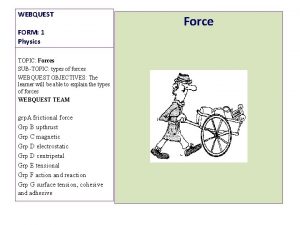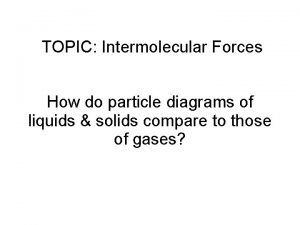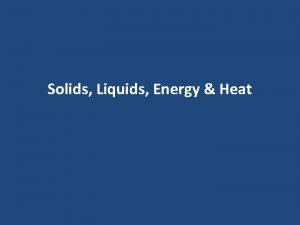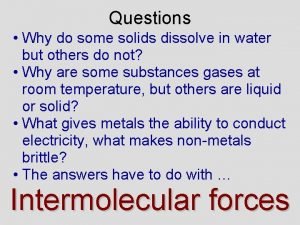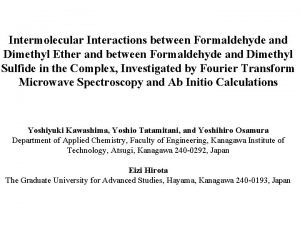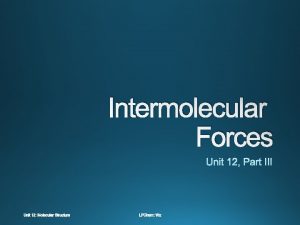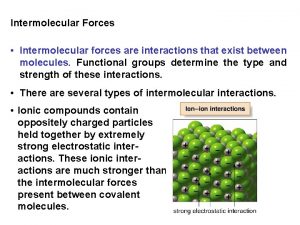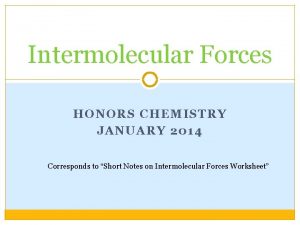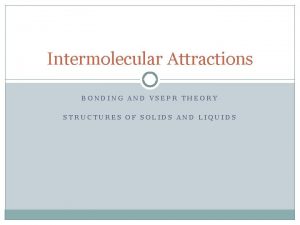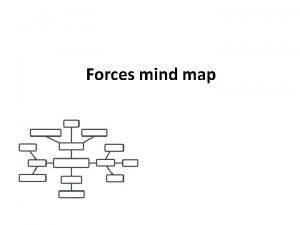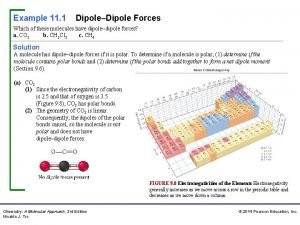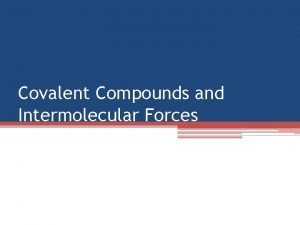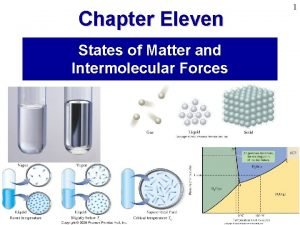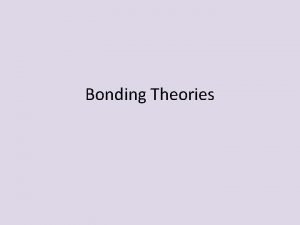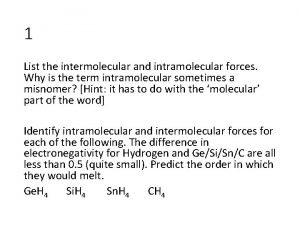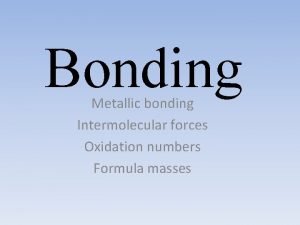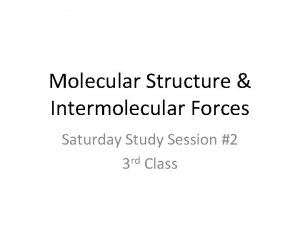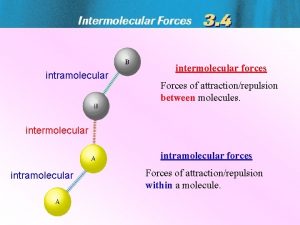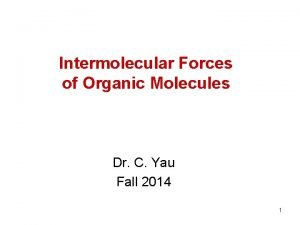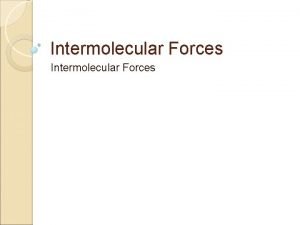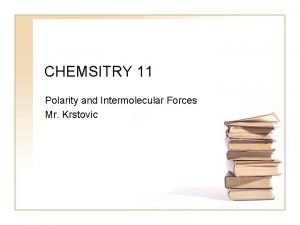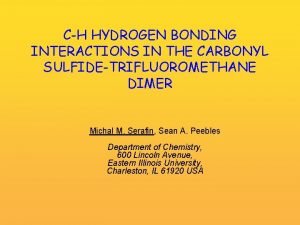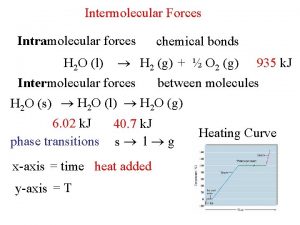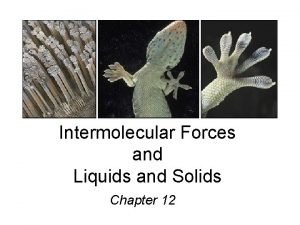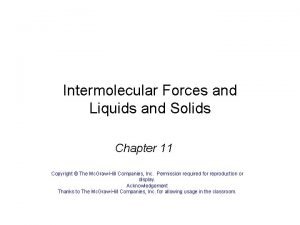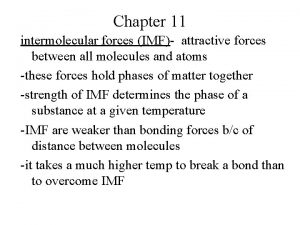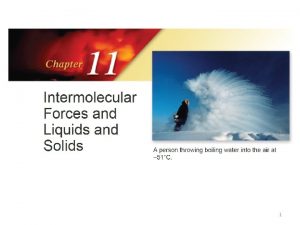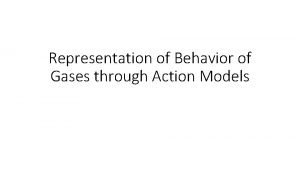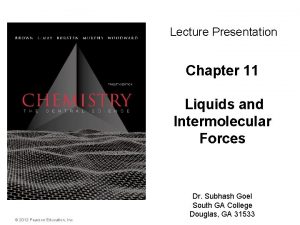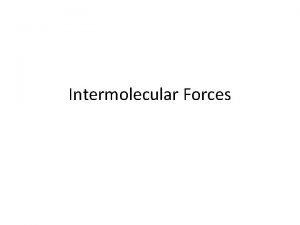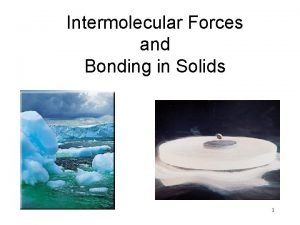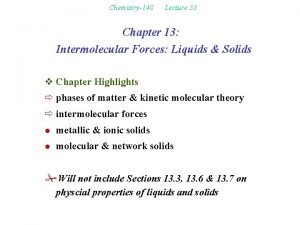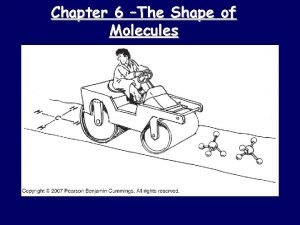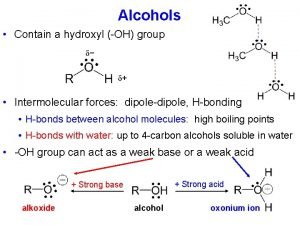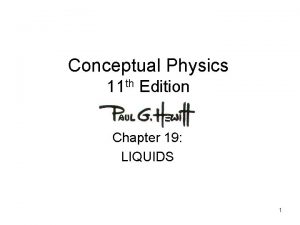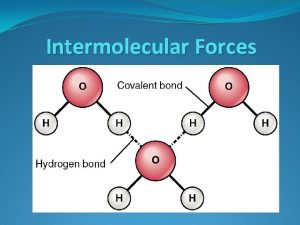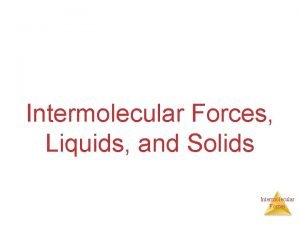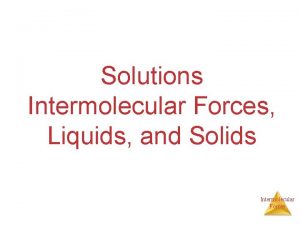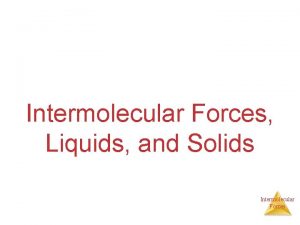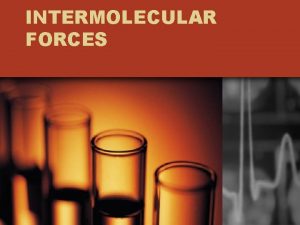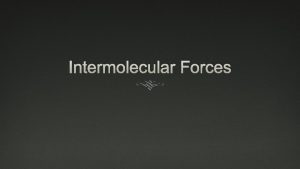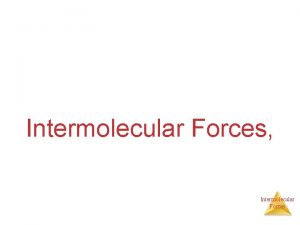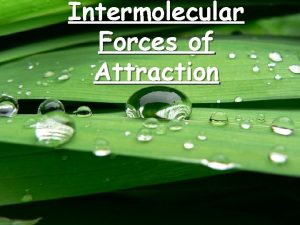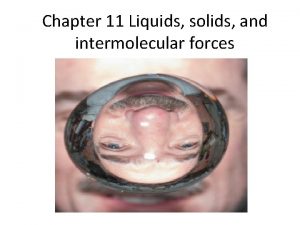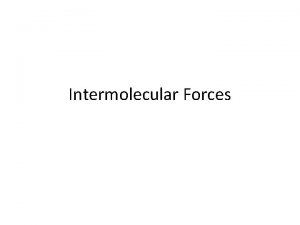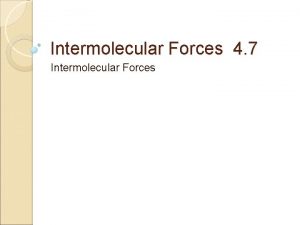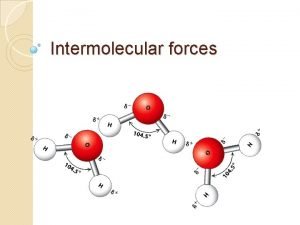Chapter 11 Liquids and Intermolecular Forces 11 1







































































- Slides: 71

Chapter 11 Liquids and Intermolecular Forces

11. 1 A Molecular Comparison of Gases, Liquids, and Solids

§ The fundamental States difference between states of matter is the strength of the intermolecular forces of attraction. § Stronger forces bring molecules closer together. § Solids and liquids are referred to as the condensed phases. of Matter

For a given substance, do you expect the density of the substance in its liquid state to be closer to the density in the gaseous state or in the solid state? a. It is closer to the density of a gas. b. It is closer to the density of a solid. c. Both are somewhat close to one another in density. d. They are significantly different in density.

Differences in the States of Matter

Which State of Matter? § The answer to this question largely relies on the Øbalance between the kinetic energies of the particles. Øinterparticle energies of attraction.

11. 2 Intermolecular Forces

Intermolecular Forces § The attractions between molecules are not nearly as strong as the intramolecular attractions (bonds) that hold compounds together. § Many physical properties reflect intermolecular forces, like boiling points, melting points, viscosity, surface tension, and capillary action.

How would you expect the H—Cl distance represented by the red dotted line to compare with the H— Cl distance within the HCl molecule? a. Smaller distance b. Larger distance c. Same distance

When water boils, what are the bubbles composed of? a. Oxygen b. Water c. Carbon dioxide d. Other impurities

Types of Intermolecular Force § Weakest to strongest forces: Ødispersion forces (or London dispersion forces) Ødipole–dipole forces Øhydrogen bonding (a special dipole– dipole force) Øion–dipole forces o Note: The first two types are also referred to collectively as van der Waals forces.

Dispersion Forces § The figure below shows how a nonpolar particle (in this case a helium atom) can be temporarily polarized to allow dispersion force to form. § The tendency of an electron cloud to distort is called its polarizability.

Factors Which Affect Amount of Dispersion Force in a Molecule § number of electrons in an atom (more electrons, more dispersion force) § size of atom or molecule/molecular weight § shape of molecules with similar masses (more compact, less dispersion force)

Polarizability & Boiling Point § If something is easier to polarize, it has a lower boiling point. § Remember: This means less intermolecular force (smaller molecule: lower molecular weight, fewer electrons).

Why is the boiling point of the halogen in each period greater than the noble gas? a. The halogen gas molecules are closer together than the noble gas molecules. b. The noble gas dispersion forces are greater. c. The halogen molecule dispersion forces are greater. d. The halogen molecule dipole forces are greater.

List the substances CCl 4, CBr 4, and CH 4 in order of increasing boiling point. a. CH 4 < CBr 4 < CCl 4 b. CCl 4 < CH 4 < CBr 4 c. CH 4 < CCl 4 < CBr 4 d. CBr 4 < CCl 4 < CH 4

Dipole–Dipole Interactions § Polar molecules have a more positive and a more negative end–a dipole (two poles, δ+ and δ−). § The oppositely charged ends attract each other.

Dipole–Dipole Interactions For molecules of approximately equal mass and size, the more polar the molecule, the higher its boiling point.

Moving from left to right, do the dispersion forces get stronger, get weaker, or stay roughly the same in the molecules shown here? a. Stronger b. Weaker c. About the same

Which Have a Greater Effect: Dipole–Dipole Interactions or Dispersion Forces? § If two molecules are of comparable size and shape, dipole–dipole interactions will likely be the dominating force. § If one molecule is much larger than another, dispersion forces will likely determine its physical properties.

What Does This Graph Show Us? § In a group, the period 3/4/5 elements have higher boiling points as the group member gets larger. § What happens with the period 2 elements? For group 4 A, the trend is continued. What about for the other groups?

Why is the boiling point of Si. H 4 higher than that of CH 4? a. Si. H 4 is more polar than CH 4. b. Si. H 4 is smaller in size than CH 4. c. Si. H 4 has greater internal dispersion forces than in CH 4. d. Si. H 4 is ionic in structure and CH 4 is molecular.

Hydrogen Bonding § The dipole–dipole interactions experienced when H is bonded to N, O, or F are unusually strong. § We call these interactions hydrogen bonds. § A hydrogen bond is an attraction between a hydrogen atom attached to a highly electronegative atom and a nearby small electronegative atom in another molecule or chemical group.

To form a hydrogen bond what must the non-hydrogen atom (N, O, or F) involved in the bond possess? a. The non-hydrogen atom must have a nonbonding electron pair. b. The non-hydrogen atom must have low electronegativity. c. The non-hydrogen atom must have a large atomic size. d. The non-hydrogen atom must have a small electron affinity.

What Forms Hydrogen Bonds? § Hydrogen bonding arises in part from the high electronegativity of nitrogen, oxygen, and fluorine. § These atoms interact with a nearly bare nucleus (which contains one proton).

Sample Exercise 11. 1 In which of the following substances is hydrogen bonding likely to play an important role in determining physical properties? methane (CH 4) hydrazine (H 2 NNH 2) methyl fluoride (CH 3 F) hydrogen sulfide (H 2 S)

Practice Exercise 1 Which of the following substances is most likely to be a liquid at room temperature? (a) Formaldehyde, H 2 CO (b) fluoromethane, CH 3 F (c) hydrogen cyanide, HCN (d) hydrogen peroxide, H 2 O 2 (e) hydrogen sulfide, H 2 S

Practice Exercise 2 In which of these substances is significant hydrogen bonding possible: methylene chloride (CH 2 Cl 2) phosphine (PH 3) chloramine (NH 2 Cl) acetone (CH 3 COCH 3)

What is the approximate H—O • • H bond angle in ice, where H—O is the covalent bond and O • • H is the hydrogen bond? a. 90° b. 109° c. 120° d. 180°

What major type of attractive interaction must be overcome for water to evaporate? a. Hydrogen bonding b. Dispersion forces c. Covalent bonds d. Dipole-dipole forces

Ion–Dipole Interactions § Ion–dipole interactions are found in solutions of ions. § The strength of these forces is what makes it possible for ionic substances to dissolve in polar solvents.

In which mixture do you expect to find ion dipole forces between solute and solvent? CH 3 OH in water or Ca(NO 3)2 in water. a. CH 3 OH in water, because CH 3 OH is a strong electrolyte and forms ions. b. Ca(NO 3)2 in water, because Ca(NO 3)2 is a strong electrolyte and forms ions. c. CH 3 OH in water, because CH 3 OH is a weak electrolyte and forms ions. d. Ca(NO 3)2 in water, because Ca(NO 3)2 is a weak electrolyte and forms ions.

Why does the O side of H 2 O point toward the Na+ ion? a. The H atoms repel the Na+ ion. b. The H atoms are attracted to other H 2 O molecules. c. The angle of the HOH bond requires this orientation. d. The negatively charged O is attracted to the positive Na+.

Summarizing Intermolecular Forces

At which point in this flowchart would a distinction be made between Si. H 4 and Si. H 2 Br 2? a. The presence of ions b. The presence of polar molecules c. H atoms bonded to N, O, and F d. The flow chart would not differentiate between them.

Practice § which has highest boiling pt? § HF, HCl, or HBr? § Identify the most important intermolecular forces : § Ba. SO 4 § H 2 S § Xe § C 2 H 6 § P 4 § H 2 O § Cs. I ionic dipole-dipole H-bonding London Dispersion

Which has stronger IMF’s? § CO 2 or OCS § SF 2 or SF 6 § PF 3 or PF 5 § SO 3 or SO 2

Sample Exercise 11. 2 List the substances Ba. Cl 2, H 2, CO, HF, and Ne in order of increasing boiling points. Practice Exercise 2 (a) Identify the intermolecular attractions present in the following substances, and (b) select the substance with the highest boiling point: CH 3, CH 3 OH, and CH 3 CH 2 OH.

Practice Exercise 1 List the substances Ar, Cl 2, CH 4, and CH 3 COOH in order of increasing strength of intermolecular attractions. (a) CH 4 < Ar < CH 3 COOH < Cl 2 (b) Cl 2 < CH 3 COOH < Ar < CH 4 (c) CH 4 < Ar < Cl 2 < CH 3 COOH (d) CH 3 COOH < Cl 2 < Ar < CH 4 (e) Ar < Cl 2 < CH 4 < CH 3 COOH

11. 3 Select Properties of Liquids

Liquid Properties Affected by Intermolecular Forces § boiling point (previously discussed) and melting point § viscosity § surface tension § capillary action

Viscosity § Resistance of a liquid to flow is called viscosity. § It is related to the ease with which molecules can move past each other. § Viscosity increases with stronger intermolecular forces and decreases with higher temperature.

Surface Tension § Water acts as if it has a “skin” on it due to extra inward forces on its surface. Those forces are called the surface tension.

How do viscosity and surface tension change? (a) as temperature increases (b) as intermolecular forces of attraction become stronger a. Viscosity increases as intermolecular forces increase while surface tension decreases. Both viscosity and surface tension increase with increasing temperature. b. Viscosity decreases as intermolecular forces increase while surface tension increases. Both viscosity and surface tension increase with decreasing temperature. c. Both viscosity and surface tension increase as intermolecular forces increase and temperature decreases. d. Both viscosity and surface tension decrease as intermolecular forces increase and temperature increases.

Cohesion and Adhesion § Intermolecular forces that bind similar molecules to one another are called cohesive forces. § Intermolecular forces that bind a substance to a surface are called adhesive forces. § These forces are important in capillary action.

Capillary Action § The rise of liquids up narrow tubes is called capillary action. § Adhesive forces attract the liquid to the wall of the tube. § Cohesive forces attract the liquid to itself. § Water has stronger adhesive forces with glass; mercury has stronger cohesive forces with itself.

If the inside surface of each tube were coated with wax, would the general shape of the water meniscus change? Would the general shape of the mercury meniscus change? Shape of Water Meniscus Shape of Hg Meniscus a. Yes, inverted U Yes, downward U b. No change Yes, downward U c. No change d. Inverted U No change

11. 4 Phase Changes

Phase Changes § Conversion from one state of matter to another is called a phase change. § Energy is either added or released in a phase change. § Phase changes: melting/freezing, vaporizing/condensing , subliming/depositing.

How is energy evolved in deposition related to those for condensation and freezing? a. Its magnitude is the difference between condensation and freezing. b. Its magnitude is opposite of the sum of condensation and freezing. c. Its magnitude is equal to the sum of condensation and freezing. d. Cannot tell from the figure

Energy Change & Change of State § The heat of fusion is the energy required to change a solid at its melting point to a liquid. § The heat of vaporization is the energy required to change a liquid at its boiling point to a gas. § The heat of sublimation is the energy required to change a solid directly to a gas.

Is it possible to calculate the heat of sublimation for a substance given its heats of vaporization and fusion? If so, what is the relationship? a. No, because we are not dealing with state functions. b. No, because we need heat from melting. c. Yes, ΔHsub = ΔHfus + ΔHvap d. Yes, ΔHsub = ΔHfus – ΔHvap

What is the name of the phase change that occurs when ice left at room temperature changes to liquid water? Is this change exothermic or endothermic? a. Melting (or fusion) and endothermic b. Melting (or fusion) and exothermic c. Freezing and endothermic d. Freezing and exothermic

Heating Curves § A plot of temperature vs. heat added is called a heating curve. § Within a phase, heat is the product of specific heat, sample mass, and temperature change. § The temperature of the substance does not rise during a phase change. • For the phase changes, the product of mass and the heat of fusion of vaporization is heat.

What process is occurring between points C and D? a. Melting b. Vaporization c. Heating the solid d. Heating the liquid

Sample Exercise 11. 3 Calculate the enthalpy change upon converting 25 g of ice at – 25 °C to water vapor (steam) at 125 °C under a constant pressure of 1 atm. The specific heats of ice, water, and steam are 2. 03 J/g-K, 4. 18 J/g-K, and 1. 84 J/g-K, respectively. For H 2 O, ΔHfus = 6. 01 k. J/mol and ΔHvap = 40. 67 k. J/mol.

Practice Exercise 1 What information about water is needed to calculate the enthalpy change for converting 1 mol H 2 O(g) at 100 °C to H 2 O(l) at 80 °C? (a) Heat of fusion (b) heat of vaporization (c) heat of vaporization and specific heat of H 2 O(g) (d) heat of vaporization and specific heat of H 2 O(l) (e) heat of fusion and specific heat of H 2 O(l).

Practice Exercise 2 § What is the enthalpy change during the process in which 100. 0 g of water at 50. 0 °C is cooled to ice at – 30. 0 °C ?

Supercritical Fluids § Gases liquefies when pressure is applied. § The temperature beyond which a gas cannot be compressed is called its critical temperature. The pressure needed to compress the liquid at critical temperature is called critical pressure. § The state beyond this temperature is called a supercritical fluid.

Why are the critical temperature and pressure for H 2 O so much higher than those for H 2 S, a related substance? a. The mass difference between H 2 S and H 2 O b. H 2 S makes strong hydrogen bonds. c. H 2 O makes strong hydrogen bonds.

11. 5 Vapor Pressure

Vapor Pressure § At any temperature, some liquid molecules have enough energy to escape the surface and become a gas. § As the temperature rises, the fraction of molecules that have enough energy to break free increases.

As the temperature increases, does the rate of molecules escaping into the gas phase increase or decrease? a. Increases b. Decreases

Vapor Pressure § As more molecules escape the liquid, the pressure they exert increases. § The liquid and vapor reach a state of dynamic equilibrium: liquid molecules evaporate and vapor molecules condense at the same rate.

Which compound do you think is more volatile at 25 °C: CCl 4 or CBr 4? a. CBr 4, because dispersion forces between its molecules are greater than in CCl 4. b. CBr 4, because polar forces between its molecules are smaller than in CCl 4. c. CCl 4, because polar forces between its molecules are greater than in CBr 4. d. CCl 4, because dispersion forces between its molecules are smaller than in CBr 4.

Vapor Pressure § The boiling point of a liquid is the temperature at which its vapor pressure equals atmospheric pressure. § The normal boiling point is the temperature at which its vapor pressure is 760 torr.

What is the vapor pressure of ethylene glycol at its normal boiling point? a. 260 torr b. 460 torr c. 660 torr d. 760 torr

Vapor Pressure § The natural log of the vapor pressure of a liquid is inversely proportional to its temperature. § This relationship is quantified in the Clausius–Clapeyron equation.

Sample Exercise 11. 4 § 1) Use Figure 11. 25 to estimate the boiling point of diethyl ether under an external pressure of 0. 80 atm. § 2) At what external pressure will ethanol have a boiling point of 60ºC?

Practice Exercise 1 In the mountains, water in an open container will boil when (a) its critical temperature exceeds room temperature (b) its vapor pressure equals atmospheric pressure (c) its temperature is 100 °C (d) enough energy is supplied to break covalent bonds (e) none of these is correct

Integrative Exercise § CS 2 has a melting point of -110. 8ºC and a boiling point of 46. 3ºC. Its density at 20ºC is 1. 26 g/cm 3. It is highly flammable. § A) What is the compound’s name? § B) List the intermolecular forces that CS 2 molecules would have with each other. § C) Write a balanced equation for the combustion of this substance. § D) The critical temperature and pressure for CS 2 are 552 K and 78 atm. Compare these values with those of CO 2 (304. 3 K and 73 atm) and discuss the origin of their differences.
 Intramolecular vs intermolecular bonds
Intramolecular vs intermolecular bonds Difference between intramolecular and intermolecular
Difference between intramolecular and intermolecular Intermolecular force of attraction
Intermolecular force of attraction Intermolecular and intramolecular forces
Intermolecular and intramolecular forces Geckos and intermolecular forces
Geckos and intermolecular forces Similarities of intermolecular and intramolecular forces
Similarities of intermolecular and intramolecular forces Viscosity and intermolecular forces
Viscosity and intermolecular forces Capillary action and intermolecular forces
Capillary action and intermolecular forces Attraction
Attraction Interatomic and intermolecular forces
Interatomic and intermolecular forces Unit 3 intermolecular forces and properties
Unit 3 intermolecular forces and properties Example of ion dipole
Example of ion dipole Electronegativity intermolecular forces
Electronegativity intermolecular forces Functional groups and intermolecular forces
Functional groups and intermolecular forces Intermolecular forces review
Intermolecular forces review Ch2cl intermolecular forces
Ch2cl intermolecular forces Intermolecular forces webquest
Intermolecular forces webquest Intermolecular forces
Intermolecular forces 3 types of intermolecular forces
3 types of intermolecular forces Imf chem
Imf chem How do intermolecular forces affect solvation
How do intermolecular forces affect solvation Dipole dipole interaction example
Dipole dipole interaction example Phthatic
Phthatic Formaldehyde intermolecular forces
Formaldehyde intermolecular forces Intermolecular forces symbol
Intermolecular forces symbol Dipole dipole interaction example
Dipole dipole interaction example Boiling point with intermolecular forces
Boiling point with intermolecular forces 3 types of intermolecular forces
3 types of intermolecular forces Strongest to weakest intermolecular forces
Strongest to weakest intermolecular forces Intermolecular forces from strongest to weakest
Intermolecular forces from strongest to weakest Ch2cl intermolecular forces
Ch2cl intermolecular forces Intermolecular forces hydrogen bonding
Intermolecular forces hydrogen bonding Types of force mind map
Types of force mind map Ch2cl intermolecular forces
Ch2cl intermolecular forces Coh2 intermolecular forces
Coh2 intermolecular forces Is matter
Is matter Hybrid bonding
Hybrid bonding Idf
Idf List of intermolecular forces
List of intermolecular forces Comic strip about intermolecular forces
Comic strip about intermolecular forces Which of the following imfas is considered as the weakest
Which of the following imfas is considered as the weakest Metallic bond formula
Metallic bond formula Strongest intermolecular force
Strongest intermolecular force Sucrose intermolecular forces
Sucrose intermolecular forces Hco2h intermolecular forces
Hco2h intermolecular forces Intramolecular vs intermolecular forces
Intramolecular vs intermolecular forces Cnh5 intermolecular forces
Cnh5 intermolecular forces Carbonyl sulfide intermolecular forces
Carbonyl sulfide intermolecular forces Surface tension intermolecular forces
Surface tension intermolecular forces Liquid properties
Liquid properties Hbr intermolecular forces
Hbr intermolecular forces Intermolecular forces
Intermolecular forces Dipole induced dipole forces examples
Dipole induced dipole forces examples Intermolecular forces
Intermolecular forces Poem about intermolecular forces
Poem about intermolecular forces Adhesive force
Adhesive force London dispersion force
London dispersion force Attractive forces chemistry
Attractive forces chemistry Intermolecular forces
Intermolecular forces Intermolecular forces
Intermolecular forces Pbr3 trigonal pyramidal
Pbr3 trigonal pyramidal Naming alcohols
Naming alcohols Chapter 14 solids liquids and gases worksheet answers
Chapter 14 solids liquids and gases worksheet answers Chapter 14 solids liquids and gases
Chapter 14 solids liquids and gases Chapter 11 - states of matter: liquids and solids
Chapter 11 - states of matter: liquids and solids Parallel force system example problems
Parallel force system example problems Force and motion
Force and motion Net force
Net force Constructive and destructive forces examples
Constructive and destructive forces examples Chapter 19 liquids exercises answers
Chapter 19 liquids exercises answers The forces shown above are
The forces shown above are Thermal expansion and contraction examples
Thermal expansion and contraction examples




